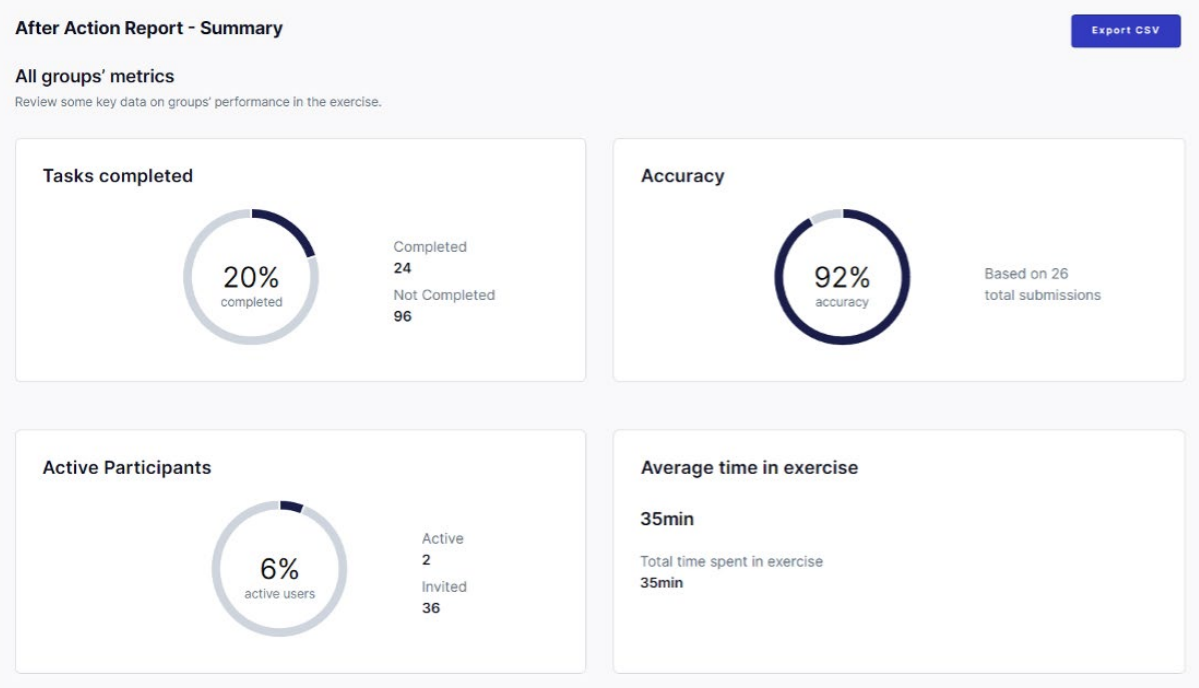During a recent initiative, we asked several Immersive Labs’ customers to engage in a series of exercises to assess their technical team skills using our Team Sim solution. Team Sim challenges users to solve various problems at a technical level – all within an easily accessible pre-configured cyber range. For this benchmarking exercise, users played the role of a SOC analyst, employing various defensive techniques such as incident response and threat hunting.
We evaluated all of the teams in three main categories: task completion, accuracy, and time to complete. The outcomes of these tests were very enlightening; impressively, all of the organizations demonstrated the fundamental capabilities needed to counter unsophisticated threat actors – as long as they had adequate visibility and tools.

Sample of benchmark data
To ensure preparedness, we recommend that businesses routinely employ technical team exercises and simulations to evaluate and benchmark their cyber capabilities. In this blog, we’ll explore the significance of benchmarking against other organizations and how it can enhance crisis response by providing valuable insights and fostering continuous improvement.
Understanding the Need for Benchmarking
When organizations undertake cybersecurity exercises, effectively measuring their performance is crucial. With a benchmark, assessing the effectiveness of a team’s response becomes even more critical because it also provides context. Comparing results against other teams facing the exact same scenario is vital for gaining perspective and identifying areas of improvement. Benchmarking provides a reference point against which an organization’s capabilities and performance can be evaluated objectively.
Leveraging Comparative Analysis
Benchmarking empowers organizations with comparative analysis, allowing them to better identify gaps in their crisis response strategies. By evaluating their performance against other teams, they can uncover discrepancies and inefficiencies that may otherwise go unnoticed. Comparative analysis sheds light on innovative techniques, best practices, and successful strategies employed by high-performing teams to enhance existing processes, develop new approaches, and drive continuous improvement.
Encouraging Collaboration and Knowledge Sharing
Benchmarking fosters a culture of collaboration and knowledge sharing within the cybersecurity community. Organizations can establish connections with peers, exchange ideas, and gain insights into different approaches by participating in benchmarking exercises. This collaborative environment nurtures a collective effort towards improving crisis response capabilities industry-wide. Through sharing lessons learned, best practices, and a little friendly competition, teams can enhance their skills and stay at the forefront of cybersecurity readiness.
Identifying Strengths and Areas of Improvement
Benchmarking allows organizations to gain a comprehensive understanding of their strengths and weaknesses. By comparing their performance to that of other teams, they can pinpoint areas where they excel and areas that require improvement. This analysis helps prioritize investments in training, tools, and technologies, ensuring that resources are allocated effectively to address vulnerabilities and build upon existing strengths. It also aids in setting realistic goals and targets for future crisis response exercises.
Driving Continuous Improvement
One of the key benefits of benchmarking is its ability to drive continuous improvement. By establishing a baseline through benchmarking, organizations can track their progress over time and measure the impact of their efforts. Regularly participating in benchmarking exercises enables teams to monitor their growth, identify emerging trends, and adapt their strategies accordingly. This iterative process ensures that crisis response capabilities are continuously refined, keeping pace with the evolving threat landscape.
Conclusion
Benchmarking plays a pivotal role in enhancing crisis response capabilities for organizations operating in the cybersecurity domain. By comparing their performance against other teams facing the same scenarios, organizations gain valuable insights, identify areas of improvement, and drive continuous progress. The power of benchmarking lies in its ability to facilitate comparative analysis, encourage collaboration and knowledge sharing, and foster a culture of continuous improvement. As the threat landscape expands, benchmarking will remain an invaluable tool in ensuring the effectiveness and readiness of cybersecurity teams worldwide.
Incorporating benchmarking into crisis response exercises empowers organizations to stay ahead of adversaries, strengthen their cybersecurity posture, and safeguard their valuable assets. By embracing this practice, organizations can harness the collective knowledge and experience of the cybersecurity community, fortify their defenses, and respond effectively to the ever-changing cyber threat landscape. Contact your Immersive Labs Sales Representative if you want to be included in our next benchmarking exercise.
Learn more about Team Sim here.


